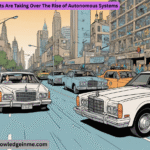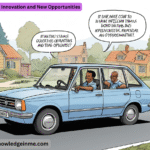Staying Competitive in a Rapidly Evolving Market Staying competitive in a rapidly evolving market requires agility, innovation, and strategic foresight. Here’s a structured approach to maintaining an edge:
Embrace Continuous Learning & Market Awareness
- Monitor Trends: Track industry shifts, emerging technologies, and competitor moves using tools like Google Alerts, market reports, and AI-driven analytics.
- Customer Insights: Use data analytics and feedback loops to understand changing customer needs and preferences.
- Upskill Teams: Invest in training (e.g., digital skills, AI/ML, agile methodologies) to keep your workforce adaptable.
Foster a Culture of Innovation
Reward calculated risk-taking.
- Leverage Technology: Adopt automation, AI, and cloud solutions to streamline operations and enhance offerings.
- Collaborate: Partner with startups, academia, or tech firms to co-develop solutions.
Agility in Execution
- Adaptive Strategies: Use frameworks like Agile or Lean Startup to test ideas quickly and pivot if needed.
- Decentralize Decision-Making: Empower teams to act fast without bureaucratic delays.
- Scalable Systems: Build flexible infrastructure (e.g., modular tech stacks, cloud-based tools) to scale up/down as needed.
Customer-Centric Differentiation
- Hyper-Personalization: Use AI-driven customization (e.g., tailored recommendations, dynamic pricing).
- Exceptional CX: Prioritize seamless omnichannel experiences and rapid problem resolution.
- Build Community: Engage users via loyalty programs, social media, or user-generated content.
Competitive Pricing & Business Models
- Subscription/aaS Models: Offer flexible options (e.g., SaaS, rentals) to attract budget-conscious clients.
- Cost Optimization: Use automation and outsourcing to reduce overhead without sacrificing quality.
Strategic Differentiation
- Niche Focus: Dominate a specialized segment before expanding.
- Brand Storytelling: Highlight unique values (sustainability, ethics, innovation) to stand out.
- IP Protection: Patent innovations to create barriers for competitors.
Resilient Leadership & Mindset
- Scenario Planning: Prepare for disruptions (e.g., economic shifts, tech breakthroughs) with contingency plans.
- Employee Retention: Foster engagement through flexibility, purpose, and growth opportunities.
- Long-Term Vision: Balance short-term wins with investments in future-ready initiatives (e.g., AI, sustainability).
Measure & Iterate
- KPIs: Track metrics like customer retention, time-to-market, and innovation ROI.
Key Takeaways
- Stay paranoid—even leaders can be disrupted (e.g., Blockbuster, Kodak).
- Speed beats perfection in fast-moving markets.
- Customer obsession is the ultimate moat.
How to Execute:
Real-Time Competitive Tracking:
- Tools: SEMrush (for digital competitors Crunchbase (for funding trends), Google Trends (for demand shifts).
Customer Sentiment Analysis:
- Use AI tools (e.g., Brandwatch, MonkeyLearn) to analyze social media and reviews.
- Example: Starbucks adjusts menus based on regional social media chatter.
Weak Signal Detection:
- Look for early adopters (e.g., tech forums, niche influencers) to spot trends before they explode.
- Example: Nike identified the athleisure wave via fitness subreddits and influencer collabs.
Agile Innovation Frameworks
Why It Matters:
- Traditional R&D cycles (2–5 years) are too slow. Winners like Amazon and Apple iterate fast.
Lean Startup Method:
- Build → Measure → Learn loops (e.g., Dropbox started with a demo video to validate demand).
- MVP (Minimum Viable Product) Testing: Launch fast, gather feedback, refine.
Open Innovation:
- Partner with startups (Unilever’s Foundry program) or crowdsource ideas (LEGO Ideas).
- Hackathons & Innovation Sprints:
- Example: Google’s 20% time led to Gmail and AdSense.
Tech-Driven Competitive Moats
Why It Matters:
- Tech isn’t just an enabler—it’s a differentiator. Tesla’s over-the-air updates and Zara’s AI-driven supply chain outpace competitors.
How to Execute:
AI & Automation:
- Chatbots (e.g., Bank of America’s Erica) cut costs while improving CX.
- Predictive Analytics (e.g., Netflix’s recommendation engine) boosts retention.
Blockchain for Trust:
- DeBeers uses blockchain to verify diamond origins, combating counterfeits.
Edge Computing:
- Walmart’s edge servers optimize inventory in real time.
Pricing & Business Model Warfar
Why It Matters:
- Uber disrupted taxis with dynamic pricing.
How to Execute:
- Dynamic Pricing:
- Use AI tools like Pros or Revionics to adjust prices in real time (e.g., Airbnb).
Freemium Models:
- Example: Slack hooked users with free tiers, then upsold enterprises.
Talent & Culture as a Weapon
Why It Matters:
- Netflix’s “no rules” culture and Google’s psychological safety drive innovation.
How to Execute:
- Hire for Adaptability:
- Foster a Growth Mindset:
- Amazon’s “Day 1” philosophy treats every day like a startup.
Preemptive Disruption
Why It Matters:
- If you don’t disrupt yourself, someone else will (Kodak vs. Instagram).
How to Execute:
- Kill Your Own Products (Before Competitors Do):
- Example: Apple replaced iPods with iPhones.
Acqui-Hire Emerging Threats:
- Facebook bought Instagram to neutralize competition.
Spin Off Innovation Labs:
- Alphabet’s “Other Bets” (Waymo, Verily) explore moonshots.
Predictive Market Domination: See Around Corners
A. Advanced Trend Hunting
- Dark Data Mining
- Scrape niche forums (Reddit, Discord), patent filings, and academic papers for weak signals.
- Example: Moderna tracked mRNA research for a decade before COVID made it vital.
- War Gaming Competitors
- Run “pre-mortems”: Assume rivals have already beaten you—reverse-engineer how.
- Tool: McKinsey’s Three Horizons Model balances current ops vs. future bets.
B. Customer Anticipation Engine
- Case Study: Target’s pregnancy prediction model identified expectant mothers before they announced.
Hyper-Innovation: Building the Future Before It’s Needed
A. Disruptive Innovation Frameworks
- Blue Ocean Strategy
- Create uncontested markets (Example: Cirque du Soleil merged circus/theater).
- Tool: Strategy Canvas to visualize differentiation.
B. Rapid Prototyping at Scale
- Digital Twins: Simulate products in metaverse environments before physical production (Example: Siemens’ factory simulations).
- 3D Printing: Adidas’ 4D shoes were prototyped in hours, not months.
Asymmetric Warfare: Winning Without Direct Competition
A. Stealth Differentiation
- Embedded Defensibility
- Network Effects: Like LinkedIn’s recruiter/job seeker flywheel.
- Data Moats: Waze’s real-time traffic data improves as more users join.
Regulatory Arbitrage
- Shape policies to favor your model (Example: Tesla’s carbon credits funded early growth).
B. Guerrilla Pricing Tactics
- “Bait-and-Hook”: Sell razors cheap, lock in blade sales (Example: HP printers/ink model).
- Dynamic Surge Pricing: Disney’s Genie+ charges more for peak ride access.
Talent as a Scalpel: Building an Army of Innovators
A. Silicon Valley-Grade Talent Hacks
- Micro-Acquisitions (“Acqui-Hires”)
- Buy tiny teams for their skills (Example: Google’s 200+ acquisitions for AI talent).
- Fractional Executives
- Staying Competitive in a Rapidly Evolving Market Rent top-tier C-suite talent part-time (Example: Startups using Patreon’s ex-CPO as advisor).
B. Anti-Fragile Culture
- “Failure Bonuses”: Reward spectacular flops that yield learnings (Practice at Intuit).
- Internal Talent Marketplaces: Let employees pitch for projects (Used by IBM).
Supply Chain as a Weapon
A. Predictive Logistics
- AI-Driven Demand Sensing:
- Example: Zara’s 2-week production cycles vs. rivals’ 6 months.
- Blockchain Provenance:
- De Beers’ Tracr ensures conflict-free diamonds.
B. Distributed Manufacturing
- Local Micro-Factories: Uniqlo’s automated warehouses cut delivery times to hours.
- Crowdsourced Production: Threadless lets users design/print on demand.
Psychological Dominance in Marketing
A. Neuro marketing Tactics
- Scarcity Hacks: Amazon’s “Only 3 left!” triggers urgency.
- Choice Architecture: Robinhood’s confetti animations reinforce trading behavior.
B. Memetic Warfare
- Engineer viral loops (Example: Duolingo’s TikTok memes drove 500M+ installs).
- Archetype Branding:
- Nike = “Hero” (Just Do It)
- Tesla = “Rebel” (Disrupt the auto industry)






